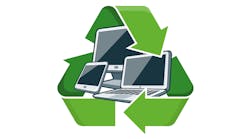In a world where global electrical and electronic waste is on track to reach 120 million tons by 2050, some organizations are coming up with innovative ways to tackle the issue, recycle devices, and keep toxic substances out of the world’s landfills.
Valued at over $62.5 billion—more than the GDP of most countries—less than 20% of e-waste is formally recycled, with 80% either ending up in landfill or being informally recycled—much of it by hand in developing countries. This not only exposes workers to hazardous and carcinogenic substances such as mercury, lead, and cadmium, but also contaminates soil and groundwater, putting food supply systems and water sources at risk, according to PACE and the UN.
To solve the problem, the organizations advocate for more durable product design; buy-back and return systems for used electronics; and urban mining to extract metals and minerals from e-waste. iFixit has another solution and is partnering with 80 colleges and universities to bring it into reality.
Here’s How it Works
According to Vice, the schools are training students to repair electronics and to help others do the same. Students take electronics apart and put them back together in order to build repair manuals so that people can fix their devices instead of throwing them out, Madeleine Gregory reports in “A New Generation of Students Is Teaching Us How to Reduce E-Waste.”
“iFixit puts these manuals on their website—tens of thousands, so far—and their advice reaches millions of people,” she writes noting that the repair guides attract about 1.5 million users a month. Students have created more than 30,000 guides on 6,000 consumer products, and have helped over 60 million people repair their devices.
What makes this program unique is the way in which it approaches device reuse. “Consumer electronics giants like Apple or Samsung churn out new phones and updates on a monthly basis,” Gregory points out. “However, there’s one thing you’ll seldom find on their websites: a repair manual for your old device. In fact, many device manufacturers go to great lengths to ensure that repairing devices yourself or through a third party is incredibly difficult, and sometimes illegal.”
As a result, when a mobile phone breaks—and if there are no instructions available on how to fix it—then the user either has to get a new one or send it in for an expensive repair. Focused on alternatives, iFixit provides the students with a device and then gets them working in groups to pull the products apart and identify common problems. “Then they solve those problems, creating a step-by-step guide with pictures, explaining exactly what they did,” Gregory writes. “By showing students how unsustainable our current system of electronics manufacturing is, iFixit hopes to push future engineers to design better, more recyclable products.”
Doing Their Part
Because the e-waste problem transcends the U.S. and impacts the entire world, organizations like Amsterdam-based Fairphone are also developing initiatives to help mitigate the growing issue. The company builds smartphones with responsible and sustainable materials, including recycled plastic, copper, and tin as well as fair trade-certified gold, according to Triple Pundit.
“Fairphone has set a goal to responsibly source 70% of these eight materials—tin, plastic, gold, tungsten, copper, cobalt, lithium, and neodymium—by the end of 2020,” Sarah Peyok writes in “Can Electronics Manufacturers Make E-Waste Go Away?”
“By forging new supplier and sub-supplier relationships and even shipping e-waste containers from countries like Ghana back to Europe in an effort to salvage batteries and recycle materials such as cobalt,” she continues, “Fairphone is showing the electronics industry what can be accomplished in an effort to spur industry-wide change.”
Peyok says HP is also doing its part to promote a circular economy. For example, it’s helping electronics “hoarders” let go of their unwanted devices by publicly offering recycling services, trade-in incentives, return for cash, or donation options as well as to safely destroy data drives and other electronics at the end of their life cycle.
“HP says it has used over half a million pounds of ocean-bound plastic in its products,” Peyok writes, “and more than 80% of HP ink cartridges and 100% of HP LaserJet toner cartridges are manufactured with recycled content.”

